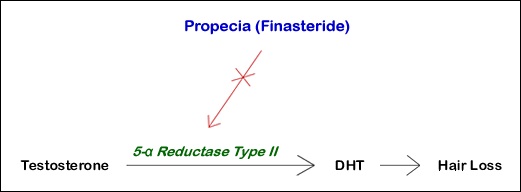Male pattern baldness or androgenetic alopecia is caused by the effects of the male hormone dihydrotestosterone (DHT) on genetically susceptible hair follicles that are present mainly in the front, top, and crown of the scalp (rather than the back and sides). DHT causes hair loss by shortening the growth, or anagen, phase of the hair cycle, causing miniaturization (decreased size) of the follicles. The effected hair becomes progressively shorter and finer until it eventually disappears.
******************************************************************************************
The source of this information on Finasteride is from Dr Bob Bernstein
on the Bernstein Medical Website : Dr. Bernstein’s information on finasteride
******************************************************************************************

DHT is formed by the action of the enzyme 5-alpha reductase on testosterone. Finasteride is a drug that works by blocking the enzyme 5-alpha reductase Type II that converts testosterone to dihydrotestosterone (DHT) in the hair follicle. Propecia, the brand name for finasteride, is the only FDA approved oral medication for hair loss.

Finasteride causes a significant drop in both scalp and blood levels of DHT and its effect is felt to be related to both of these factors. Finasteride 1-mg/day decreases serum DHT levels by almost 70%. Serum testosterone levels actually increased by 9%, but this is within the range of normal.
It is commonly thought that finasteride was first conceived as a prostate medication and that, only by chance, was found to prevent hair loss. The fact is that in 1974 the researcher Imperato-McGinley described a group of genetically male children from the village of Salinas in the Dominican Republic who were deficient in the enzyme 5-alpha reductase. These male children had very low levels of DHT and throughout their life, their prostates remained small and they did not develop male pattern hair loss or acne.
The objective of the researchers was to find a drug that could block the 5-alpha reductase enzyme and mimic the abnormality found in these men. They could then use this drug to prevent both prostate enlargement (BPH) and hair loss. The decision was made, however, to obtain FDA approval for the medical indication first, rather than the cosmetic one. As a result, in 1992, Finasteride 5-mg was released under the brand name Proscar, for use in men over 50 with prostate enlargement (the prostate also has the type II enzyme). Five years later, in 1997, the FDA approved finasteride 1-mg/day (Propecia) for the treatment of male pattern baldness.
Studies have shown that after five years of treatment, 90% of men taking finasteride maintained their hair or increased hair growth. At five years, 48% of men treated with Propecia demonstrated an increase in hair growth, 42% were rated as having no change (no further visible progression of hair loss from baseline) and 10% were rated as having lost hair when compared to baseline.
In comparison, 6% of men treated with placebo demonstrated an increase in hair growth, 19% were rated as having no change and 75% were rated as having lost hair when compared to baseline.
******************************************************************************************
The source of this information on Finasteride is from Dr Bob Bernstein
on the Bernstein Medical Website : Dr. Bernstein’s information on finasteride
******************************************************************************************
In the “Hair Count Clinical Study,” hair counts showed an average gain of 277 hairs per one-inch circle at the end of five years. These hairs were significantly larger than the fine, miniaturized hair characteristic of balding. In the “Hair Weight Clinical Study,” a 34% increase in hair weight was observed between Propecia and the placebo at 96 weeks.
EFFECTIVENESS ON THE FRONT OF THE SCALP
The indication for Propecia includes the treatment of hair loss in the front part of the scalp. There are published data from a controlled clinical trial of men with frontal hair loss that demonstrates improvement in this region of the scalp.

I personally purchase 5mg Proscar which is how propecia was discovered. I simply cut the tablet into 5ths and this enables me to get 1mg finasteride dose very cheaply.
Make sure you purchase and get your prescription from a reliable legitimate source as there are many online stores which in my opinion are not legitimate. Feel free to email me and I can put you in direct touch with reliable private GP’s to prescribe you finasterdie easily and quickly.
Email: support@spexhair.com
USING PROPECIA
Propecia should be taken once daily with or without meals. Patients must take Finasteride for one year or longer before its effects in preventing hair loss and re-growing hair can be accurately assessed. Finasteride takes up to a year or more to exert its full effects in both preventing hair loss and in re-growing hair. During the first six months you may note some thinning of your existing hair. This may be due to either progression of your hair loss before finasteride has had a chance to work or some shedding of miniaturized hair that makes way for the new healthy anagen hair to grow. It is important to be patient during this period. You should continue the medication for at least one year before you and your doctor can assess its benefits.
SIDE EFFECTS
Side effects from finasteride at the 1-mg dose are uncommon, but reversible. The one- year drug related side effects were 1.5% greater than in the control group. The data showed that 3.8% of men taking finasteride 1mg experienced some form of sexual dysfunction verses 2.1% in men treated with a placebo. The five-year side effects profile included: decreased libido (0.3%), erectile dysfunction (0.3%), and decreased volume of ejaculate (0.0%).
Most reported cases of sexual dysfunction occurred soon after starting the medication, but there have been reports of sexual dysfunction that have occurred at later points in time. The sexual side effects were reversed in those who discontinued therapy, and in 58% of those who continued treatment. After the medication was stopped, side effects generally disappeared within a few weeks. There have been anecdotal reports where side effects have persisted after discontinuation of therapy.
******************************************************************************************
The source of this information on Finasteride is from Dr Bob Bernstein
on the Bernstein Medical Website : Dr. Bernstein’s information on finasteride
******************************************************************************************
When finasteride is discontinued, only the hair that had been gained or preserved by the medication is lost. In effect, the patient returns to the level of balding where he would have been had he never used the drug in the first place. No drug interactions of clinical importance have been identified.
EFFECTS ON BODY HAIR
When finasteride is used to re-grow scalp hair, it may also inhibit the growth of body hair. The reason is that DHT stimulates the growth of body hair in adult males and the formation of DHT is blocked by finasteride. However, the genetic variation among people is too great to know how an individual person may respond. For those who may be concerned, finasteride will not increase body hair growth.
ADVERSE REACTIONS
Adverse reactions related to the breast, including breast tenderness or breast enlargement (gynecomastia), occurred in 0.4% of men taking finasteride 1-mg (Propecia), but this was no greater than in the control group. Other side effects that were not statistically significant included hypersensitivity reactions including rash, pruritus, urticaria, swelling of the lips and face, and testicular pain.
EFFECTS ON PSA
Finasteride causes a decrease in serum PSA (prostate specific antigen) by approximately 50% in normal men. Since PSA levels are used to screen for prostate enlargement and prostate cancer, it is important that your personal physician is aware that you are taking Propecia (finasteride) so that he/she may take this into account when interpreting your PSA results.
FINASTERIDE AND PROSTATE DISEASE
A study in The New England Journal of Medicine, in 2003, on finasteride 5-mg PROSCAR (not finasteride 1-mg, Propecia) reported that in the Prostate Cancer Prevention Trial (PCPT), men treated with finasteride 5mg for seven years had a 25 percent relative risk reduction for prostate cancer compared to the men treated with placebo. The authors also reported that high grade prostate cancers were found in 6.4 percent of the men treated with finasteride 5mg, compared to 5.1 percent of the men in the placebo group.
The authors were concerned that finasteride 5mg prevents or delays the appearance of prostate cancer and that this possible benefit and a reduced risk of urinary problems must be weighed against sexual side effects and the increased risk of high-grade prostate cancer. With new information, it is now felt that the increased incidence of a higher grade cancer was due to the fact that the finasteride shrunk the non-cancerous part of the enlarged prostate, making the cancerous part easier to detect on biopsy.
In fact, in 2009, the American Society of Clinical Oncology and the American Urological Association issued guidelines that recommend that healthy men consider finasteride to lower their level of the hormone dihydrotestosterone (DHT) with the goal of preventing the development of prostate cancer.
CAUTION DURING PREGNANCY
Finasteride use is contraindicated in women when they are, or may be, pregnant. Women should not handle crushed or broken Propecia tablets when they are pregnant, or may potentially be pregnant, because of the possibilities of absorption of finasteride and the subsequent potential risk to a male fetus. Propecia tablets are coated and will prevent contact with the active ingredient during normal handling, provided that the tablets have not been broken or crushed.
Exposure of pregnant women to semen from men treated with Propecia poses no risk to the fetus.
USE IN POST-MENOPAUSAL WOMEN
Merck recently carried out a study to evaluate the efficacy of finasteride in post-menopausal women. After one year there was no significant hair growth and, as a result, the study was terminated. An explanation is that hair loss in women is related more to the action of the enzyme aromatase (which is unaffected by finasteride) rather than DHT. It is also possible that the low DHT levels observed in postmenopausal women are responsible for the lack of significant response to finasteride. (See Causes of Hair Loss in Women).
LONG-TERM BENEFITS AND RISKS
The effects of finasteride are confined to areas of the scalp that are thinning, but where there is still some hair present. It does not grow hair in areas that are completely bald. Although it can regrow hair in thin areas, the major benefit of finasteride seems to be in its ability to slow down or halt hair loss. Results generally peak around one year and then are stable in the second year or decrease very slightly. Although the long-term ability of finasteride to maintain one’s hair is unknown, the majority of men find that after 5 years the medication is still working.
The benefits of finasteride will stop if the medication is discontinued. Over the 2-6 months following discontinuation, the hair loss pattern will generally return to the state that it would have been if the medication had never been used.
******************************************************************************************
The source of this information on Finasteride is from Dr Bob Bernstein
on the Bernstein Medical Website : Dr. Bernstein’s information on finasteride
******************************************************************************************
PROPECIA AND HAIR TRANSPLANTATION
Propecia (finasteride) has shown to be useful in complementing a hair transplant for several reasons:
- Propecia works best in the younger patient who may not yet be a candidate for hair transplantation.
- Propecia is less effective in the front part of the scalp, the area where surgical hair restoration can offer the greatest cosmetic improvement.
- Propecia can re-grow hair, or stabilize hair loss, in the back part of the scalp where hair transplantation may not always be indicated.
For those who choose not to take Propecia, or who cannot take it due to its side effects, the surgical hair restoration is just as effective. The only difference is that medications can prevent further hair loss whereas surgery cannot. Medications are not needed for a hair transplant to be successful or the transplanted hair to grow and be permanent.
GENERIC FINASTERIDE
Finasteride 5mg (Proscar) is available in a generic formulation. (Propecia) will not be available generically until the year 2012. For those wanting to take generic finasteride, we recommend buying a pill cutter at the pharmacy and taking ¼ of a 5mg tablet every day. Please be advised that there is no scientific data insuring that this will be as effective as Propecia 1mg a day. Also, remember that there is a potential risk to pregnant women from handling broken or crushed tablets.
INCREASING THE DOSE
We are often asked if one should increase the dose of Propecia. Although we do increase the dose under certain circumstances, there is no scientific evidence that increasing the dose will have any additional effects. There are published data demonstrating that 5 mg is no better than 1 mg from controlled clinical trials. In practice, I often increase the dose when someone has been on the same dose of medication for about three years and then stops responding (begins to lose hair after being stable). When increasing the dose, I generally use generic finasteride 5mg, ½ pill a day.
PROSTATE CANCER SCREENING
The American Cancer Society and the American Urological Association recommend the following screening ages:
- Age 50 for men who are at average risk of prostate cancer and are expected to live at least 10 more years.
- Age 45 for men at high risk of developing prostate cancer: African American men and men who have a first-degree relative (father, brother, or son) diagnosed with prostate cancer younger than age 65.
- Age 40 for men at even higher risk (those with several first-degree relatives who had prostate cancer at an early age).
- Regardless of age, yearly screening for PSA level if 2.5ng/ml or higher, and every 2 years for less than 2.5ng/ml.
******************************************************************************************
The source of this information on Finasteride is from Dr Bob Bernstein
on the Bernstein Medical Website : Dr. Bernstein’s information on finasteride
******************************************************************************************
An evaluation should include a rectal examination, a PSA, and other tests that your examining physician feels are appropriate. The above are general guidelines recommended men regardless of whether they use finasteride or not. Specific recommendations for each patient should be based upon the judgment of his own physician.
COMMON MISCONCEPTIONS ABOUT FINASTERIDE
Myth: Women can’t touch the medication.
Fact: Pregnant women should not handle crushed or broken tablets.
Myth: It only works in the crown.
Fact: It potentially works any where on the scalp where there is some hair, even in the front of the scalp.
Myth: Once you start it you must take it for ever.
Fact: You can stop the medication any time you want – you just lose its benefits when one stops.
Myth: Finasteride lowers testosterone
Fact: The medication, on average, causes a rise in serum testosterone levels by 9%.
Myth: The sexual side effects are frequent.
Fact: The sexual side effects occur in approximately 4% of patients taking the medication.
Myth: Finasteride causes birth defects if a man takes it when his wife is pregnant.
Fact: Exposure of pregnant women to semen from men treated with Propecia poses no risk to the fetus.
Myth: Propecia was originally a prostate medication that was found to prevent hair loss.
Fact: Propecia is not a prostate medication that was by chance noted to have a side effect of hair growth, it is a medication that was known since its discovery that it could grow hair.
**********************************************************************************************
For Further information relating to Finasteride you can visit Bernstein Medical Website : Dr. Bernstein information on finasteride
**********************************************************************************************





